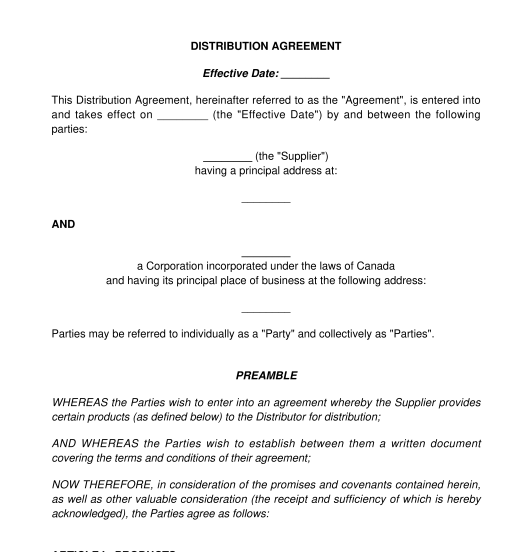 28/09/2025
28/09/2025

Answer a few questions and your document is created automatically.

Your document is ready! You will receive it in Word and PDF formats. You will be able to modify it.

 28/09/2025
28/09/2025
 Word and PDF
Word and PDF
 7 to 11 pages
7 to 11 pages
A merchandise distribution agreement, sometimes also called a distributor agreement, is a document between two parties, a supplier and a distributor. The supplier (or manufacturer) is the party that supplies or sells the goods to the distributor. The distributor is the party that distributes or resells (at retail or through other distributors) the goods that the supplier provides. The distributor may transfer the goods to retailer so they can sell it to the end-user.
The most important details of the relationship between the parties will be set out in a distribution agreement, including a description of the goods sold, how and when the distributor is expected to pay, whether the agreement is exclusive, the penalties for early termination. A contract for the distribution of goods also covers what happens in the event of a problem, such as dispute resolution.
Dispute resolution is a mechanism used by the parties to avoid having to go through the expensive court system using alternative means such as mediation or arbitration.
The primary difference between a Merchandise Distribution Agreement and a Sale of Goods Agreement is that in a Merchandise Distribution Agreement, the distirbutor is an intermediary between a supplier and end customer or retailer. On the other hand, in a Sale of Goods Agreement, the seller directly sells to the purchaser who receives ownership to the goods. In a Merchandise Distribution Agreement, ownership may still rest with the supplier until such goods are sold to the end-user.
The distributor and supplier signing the agreement may be:
The signers to the contract must be at least majority age and not under a disability. The ages of majority are as follows:
The duration of a merchandise distribution agreement may vary. The duration can be open-ended with the parties agreeing on when to terminate or cancel their agreement. The agreement can also be for a fixed-term such as 5 years or until a certain event has been satisfied. The duration of the contract is flexible and is based on the parties' needs.
After a merchandise distribution agreement is ready, the parties will need to sign it either electronically or physically. Each party will need to keep a copy of the signed agreement for their records. They should upload the signed agreement to a personal computer. Once the parties start implementing the agreement, the distributor may need to establish distribution channels and organize inventory with systems of protection in place. All transactions should be properly accounted for and recorded.
Merchandise distribution agreements are governed by specific statutes including consumer protection law, antitrust law, and potentially intellectual property and franchise law. Some pieces of legislation on consumer protection include the following:
You fill out a form. The document is created before your eyes as you respond to the questions.
At the end, you receive it in Word and PDF formats. You can modify it and reuse it.
Merchandise Distribution Agreement - Sample, template
Country: Canada (English)